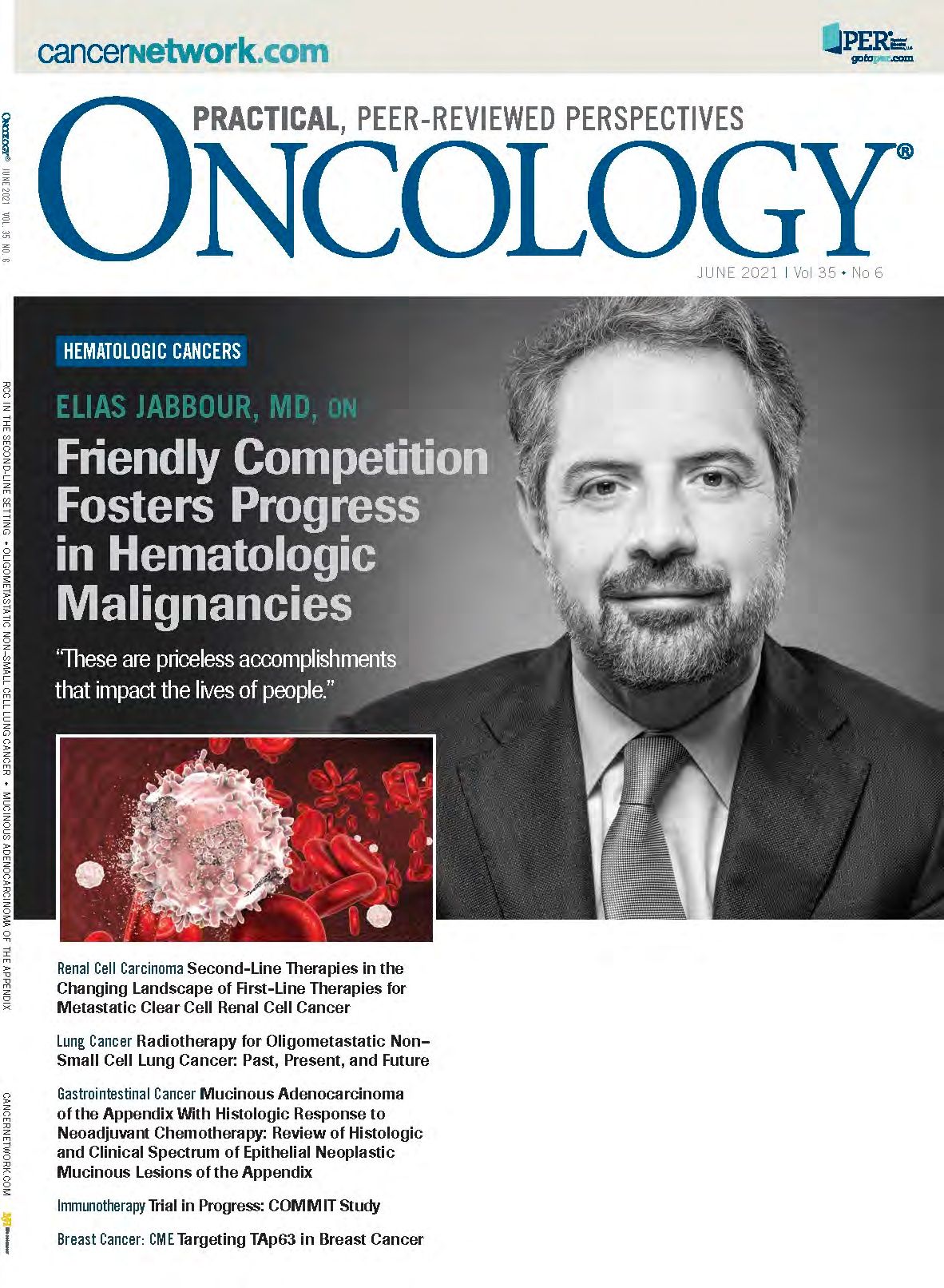Second-Line Therapies in the Changing Landscape of First-Line Therapies for Metastatic Clear Cell Renal Cell Cancer
In recent years, first-line therapies for metastatic renal cell carcinoma (mRCC) have shifted to a combination of immune checkpoint inhibitors or a combination of antiangiogenesis tyrosine kinase inhibitors (TKIs) and immunotherapy. This has led to a need to address standard-of-care treatment in the second-line setting.
Shaw is a hematology-oncology fellow at Cedars-Sinai Medical Center in Los Angeles, CA.

Lee is a hematology-oncology fellow at Cedars-Sinai Medical Center in Los Angeles, CA.

Figlin is deputy director of Cedars-Sinai Cancer and Steven Spielberg Family Chair in Hematology Oncology, professor of medicine and biomedical sciences, and deputy director of the Cedars-Sinai Oschin Comprehensive Cancer Institute in Los Angeles, CA.

ABSTRACT
In recent years, first-line therapies for metastatic renal cell carcinoma (mRCC) have shifted to a combination of immune checkpoint inhibitors or a combination of antiangiogenesis tyrosine kinase inhibitors (TKIs) and immunotherapy. This has led to a need to address standard-of-care treatment in the second-line setting. Our review presents an analysis of current and upcoming data to guide treatment decisions. After progression on nivolumab plus ipilimumab, current data favor monotherapy TKI with cabozantinib or axitinib. Current literature for second-line therapy given after combination TKI plus immunotherapy shows the strongest evidence for either single-agent cabozantinib or combination everolimus with lenvatinib. Investigations are ongoing for the role of TKIs with immunotherapy in the second-line setting. Novel agents, such as HIF2α inhibitors, are currently being studied as single agents and in combination with other treatment modalities in efforts to improve patient outcomes in mRCC.
Keywords: advanced renal cell carcinoma, immunotherapy, tyrosine kinase inhibitor, mTOR inhibitor, HIF2α inhibitor
Oncology (Williston Park). 2021;35(6):306-310.
DOI: 10.46883/ONC.2021.3506.0306
Introduction
Renal cell carcinoma (RCC) accounts for 2.2% of cancer diagnoses and 1.8% of cancer deaths across the globe and is the ninth most common cancer in the United States.1 Approximately one-third of cases are diagnosed as metastatic disease with poor 5-year survival rates of 12%. In recent years, first-line treatment of advanced or metastatic RCC has evolved substantially with the introduction of immune checkpoint inhibitors (ICIs), which have improved survival. First-line single-agent TKIs that target VEGF are quickly falling out of favor with the advent of immunotherapies. The shift in first-line treatment creates a need to readdress subsequent lines of therapies. This review presents a guide to second-line therapies based on the current evidence and highlights upcoming noteworthy studies, with a focus on clear cell histology.
First-Line Treatment Summary
In the randomized, phase 3 CheckMate 214 trial, the combination of nivolumab (Opdivo; an anti–PD-1 antibody) and ipilimumab (Yervoy; an anti–CTLA-4 antibody) was compared with single-agent sunitinib (Sutent; a first-generation VEGF TKI) in untreated patients of all risk groups with advanced clear cell RCC (ccRCC).2 The primary end points were overall survival (OS), objective response rate (ORR), and progression-free survival (PFS) in intermediate- and poor-risk groups. For the primary end points, the combination arm showed statistically significant benefit with an 18-month OS rate of 75% and an ORR of 42%, compared with 60% and 25%, respectively, in the control arm. The PFS benefit did not reach statistical significance. This pivotal trial led to FDA approval of nivolumab plus ipilimumab in first-line treatment of intermediate/poor-risk advanced ccRCC.
The randomized, phase 3 KEYNOTE-426 trial compared combination axitinib (Inlyta; a second-generation TKI against VEGF-1, VEGF-2, VEGF-3, and PDGFR) and pembrolizumab (Keytruda; an anti–PD-1 antibody) to single-agent sunitinib.3 The combination arm resulted in superior OS and PFS compared with the control arm across all risk groups. At 12 months, 89.9% of patients were alive in the pembrolizumab/axitinib arm vs 78.3% in the sunitinib arm, and median PFS was 15.1 months vs 11.1 months, respectively. The CheckMate 9ER trial led to another FDA-approved front-line ICI/TKI combination: cabozantinib plus nivolumab.4 Cabozantinib (Cabometyx) with nivolumab resulted in a statistically significant PFS benefit of 16.6 months vs 8.3 months with sunitinib alone. A significant OS benefit was also seen in the combination arm, with 85.7% probability of survival at 12 months vs 75.6% with sunitinib. The phase 3, randomized CLEAR trial compared lenvatinib (Lenvima) plus pembrolizumab with lenvatinib plus everolimus (Afintor) with sunitinib alone.5 The lenvatinib/pembrolizumab arm had significantly longer PFS of 23.9 months, vs 9.2 months with sunitinib alone. OS at 24 months was 79.2% with lenvatinib/pembrolizumab and 70.4% with sunitinib, a statistically significant difference. Although lenvatinib/everolimus had a significantly longer PFS compared with sunitinib, it did not have an OS benefit.
The decision to use nivolumab plus ipilimumab or a TKI/ICI combination upfront depends on several factors that include the patient’s functional status, risk stratification, and extent of disease burden, as well as institutional availability. Immunotherapy has the benefit of better tolerability compared with TKIs, while TKIs have a shorter response time. In both cases, the choice of first-line
regimen will significantly influence the approach to second-line therapy.
Second-Line Treatment Options
The approach to second-line therapies should address the mechanisms of resistance to first-line therapies and utilize different treatment modalities. If a patient has progressed on immunotherapy, the second-line regimen should include a TKI. If a patient has progressed on combination ICI/TKI treatment, the second-line regimen should include either a different TKI alone or in combination with an mTOR inhibitor. The subsequent TKI should address escape pathways that led to treatment resistance to the prior TKI, via AKT, MET, AXL and FGF signaling.6 Cabozantinib is a VEGF-TKI that also targets MET and AXL. The lack of PTEN expression and aberrant AKT activation correlates with TKI resistance, and mTOR inhibitors can overcome these mechanisms to reinstate sensitivity to TKI-mediated apoptosis.
Post–First-Line Immunotherapy
As seen in CheckMate 214, the combination of nivolumab plus ipilimumab has become one of the favored first-line treatment options in the appropriate patient population. The current standard of care after progression is a single-agent TKI, either cabozantinib or axitinib, and supportive data are extrapolated from trials of post–first-line antiangiogenesis therapy.
In the randomized, phase 2 CABOSUN trial, patients treated with cabozantinib had significantly prolonged PFS of 8.6 months vs 5.3 months with sunitinib in the up-front setting for advanced RCC.7 Furthermore, the phase 3 METEOR trial compared cabozantinib with everolimus (an mTOR inhibitor) after progression on VEGF-targeted therapies.8 Results revealed that patients who received cabozantinib achieved a superior median OS of 21.4 months vs 16.5 months with everolimus. ORR and median PFS were also statistically significantly better in the cabozantinib arm. While a retrospective analysis suggests a benefit of cabozantinib after progression on ICI-based therapies, no randomized trial data exist at this time.9 However, current data can be extrapolated to support the efficacy and use of single-agent cabozantinib as standard of care in the second-line setting.
Axitinib is another TKI option. The phase 3 AXIS trial compared axitinib with sorafenib (Nexavar; a multikinase inhibitor) after progression on any of these regimens: sunitinib, bevacizumab (Avastin) with interferon alfa, cytokine therapy, or temsirolimus.10 Results showed a statistically significant median PFS benefit of 8.3 months with axitinib compared with 5.7 months with sorafenib, although no difference in median OS was seen. Axitinib thus is recognized as another appropriate second-line option.
Current data are best established for single-agent cabozantinib or axitinib for second-line therapy after first-line combination immunotherapy. In efforts to continue to improve OS in metastatic RCC after immunotherapy, ongoing trials are examining the benefit of combination ICI/TKI therapy in the second-line setting. The recently launched phase 3 CONTACT-03 trial is exploring combination cabozantinib with atezolizumab (Tecentriq; a PD-L1 inhibitor) vs cabozantinib alone in patients who have prior exposure to ICI therapy.11 The phase 2 KEYNOTE-146 trial is studying the benefit of lenvatinib plus pembrolizumab after up-front therapy with nivolumab/ipilimumab or ICI/TKI therapy.12 At the 2020 American Society of Clinical Oncology Virtual Annual Meeting, the reported median PFS for the RCC cohort was 11.7 months and the median duration of response was 9.9 months, which suggests benefit in sequential ICI plus TKI. Final results from these trials will help determine the role of ICI plus TKI after immunotherapy, and they may change our approach to second-line treatments.
Post–First-Line Immunotherapy With TKIs
With multiple ICI/TKI combinations available in the first-line setting for advanced ccRCC, there is a need to standardize subsequent lines of therapy in this population.3-5 The benefit of cabozantinib as a second-line option was, again, extrapolated from the METEOR and CABOSUN trials.7,8 Although a retrospective analysis suggests a benefit of cabozantinib after progression on ICI/TKI combination therapies, no randomized trial data exist at this time.13 mTOR inhibitors are current key players, but they should be used in combination, as the INTORSECT trial demonstrated a lack of benefit with single-agent temsirolimus (Torisel) when compared with sorafenib in the second-line setting.14 Study 205, a randomized phase 2 trial, compared lenvatinib plus everolimus vs lenvatinib alone vs everolimus alone after progression on a VEGF-TKI.15 Results favored lenvatinib plus everolimus with superior PFS at 14.6 months vs 5.5 months with everolimus alone, although no statistically significant difference was seen when compared with the lenvatinib arm (PFS, 7.4 months). The study results led to the first FDA-approved combination of a TKI and an mTOR inhibitor. However, more high-grade toxicities occurred in the combination arm. Thus, newer-generation multi-TKIs, such as vorolanib, are being studied in combination with everolimus to identify better-tolerated regimens.16 Results from the phase 1 trial of combination vorolanib/everolimus in the second-line setting were promising and have advanced to further investigation.
Lenvatinib and pembrolizumab, a different ICI/TKI combination in the second-line setting, is the subject of the current KEYNOTE-146 trial. In the RCC cohort, 65% of patients received prior ICI/TKI combination therapy, and preliminary data suggest benefit in both PFS and response rates.12
Discussion
In the era of a paradigm shift of first-line treatment for metastatic ccRCC, uncertainties arise in the standard of care in the second-line setting. In the setting of treatment after nivolumab plus ipilimumab, current data suggest second-line therapy with single-agent cabozantinib or axitinib.7-10 After first-line use of ICI/TKI combinations, second-line therapy options include single-agent cabozantinib or the combination of everolimus plus lenvatinib.7,8,15 ICI/TKI combinations are being investigated as potential second-line therapies.11,12 While we remain interested in the outcomes of these investigations, we recommend—given the absence of data— that patients participate in clinical trials or receive FDA-approved therapies emphasized in our review.
Efforts to improve outcomes in patients with advanced ccRCC have largely been dependent on understanding the pathophysiology of the disease, which has led to the development of novel targeted agents. Novel agents that inhibit transcription factor HIF—or hypoxia inducible factor, particularly the HIF2α subunit—are on the horizon.17 About 90% of ccRCC cases carry mutations that result in defective von Hippel-Lindau protein, which leads to activation of hypoxia-inducible genes that activate VEGF.18 The upstream blockade effect of HIF2α in multiple oncogenic pathways makes it an ideal target for antitumorigenic agents in ccRCC. HIF inhibition may overcome mechanisms of resistance to mTOR inhibitors by addressing gene mutations of TSC1, TSC2, and REDD1.6 Phase 1/2 data on an oral HIF2α inhibitor, MK-6482, after patients’ progression on ICI/TKI therapy, had encouraging results, with an ORR of 24% and a disease control rate of 80% across all risk groups.18 As seen in the results of previous studies, a synergistic effect seems to emerge with the combination of different treatment modalities; therefore, HIF2α inhibitors are being studied in combination to determine efficacy and safety. A current phase 2 study is investigating the combination of belzutifan (MK-6482/PT2977) with cabozantinib in patients who have progressed after 1 or 2 lines of therapy.19 Results from HIF2α inhibitor trials will hopefully add novel treatment options for patients who have progressed on immunotherapy, TKIs, or mTOR inhibitors.
CONCLUSIONS
The prognosis for patients with advanced and metastatic RCC remains poor. Treatment paradigms for first-line therapy have shifted and left an outstanding need to understand the optimal management in subsequent lines of therapy to improve patient outcomes. In our review of current data, we hope to guide clinicians through FDA-approved second-line treatments, and we highlight upcoming trials of ICI/TKI combinations and of novel HIF2α inhibitor agents that may meaningfully prolong survival in patients with advanced and metastatic RCC.
References
1. Padala SA, Barsouk A, Thandra KC, et al. Epidemiology of renal cell carcinoma. World J Oncol. 2020;11(3):79-87. doi:10.14740/wjon1279
2. Motzer RJ, Tannir NM, McDermott DF, et al; CheckMate 214 Investigators. Nivolumab plus ipilimumab versus sunitinib in advanced renal-cell carcinoma. N Engl J Med. 2018;378(14):1277-1290. doi:10.1056/NEJMoa1712126
3. Rini BI, Plimack ER, Stus V, et al; KEYNOTE-426 Investigators. Pembrolizumab plus axitinib versus sunitinib for advanced renal-cell carcinoma. N Engl J Med. 2019;380(12):1116-1127. doi:10.1056/NEJMoa1816714
4. Choueiri TK, Powles T, Burotto M, et al; CheckMate 9ER Investigators. Nivolumab plus cabozantinib versus sunitinib for advanced renal-cell carcinoma. N Engl J Med. 2021;384(9):829-841. doi:10.1056/NEJMoa2026982
5. Motzer R, Alekseev B, Rha S-Y, et al; CLEAR Trial Investigators. Lenvatinib plus pembrolizumab or everolimus for advanced renal cell carcinoma. N Engl J Med. 2021;384(14):1289-1300. doi:10.1056/NEJMoa2035716
6. Makhov P, Joshi S, Ghatalia P, Kutikov A, Uzzo RG, Kolenko VM. Resistance to systemic therapies in clear cell renal cell carcinoma: mechanisms and management strategies. Mol Cancer Ther. 2018;17(7):1355-1364. doi:10.1158/1535-7163.MCT-17-1299
7. Choueiri TK, Hessel C, Halabi S, et al. Cabozantinib versus sunitinib as initial therapy for metastatic renal cell carcinoma of intermediate or poor risk (Alliance A031203 CABOSUN randomised trial): progression-free survival by independent review and overall survival update. Eur J Cancer. 2018;94:115-125. doi:10.1016/j.ejca.2018.02.012
8. Choueiri TK, Escudier B, Powles T, et al; METEOR Investigators. Cabozantinib versus everolimus in advanced renal cell carcinoma (METEOR): final results from a randomised, open-label, phase 3 trial. Lancet Oncol. 2016;17(7):917-927. doi:10.1016/s1470-2045(16)30107-3
9. McGregor BA, Lalani AA, Xie W, et al. Activity of cabozantinib after immune checkpoint blockade in metastatic clear-cell renal cell carcinoma. Eur J Cancer. 2020;135:203-210. doi:10.1016/j.ejca.2020.05.009
10. Motzer RJ, Escudier B, Tomczak P, et al. Axitinib versus sorafenib as second-line treatment for advanced renal cell carcinoma: overall survival analysis and updated results from a randomised phase 3 trial. Lancet Oncol. 2013;14(6):552-562. doi:10.1016/s1470-2045(13)70093-7
11. A study of atezolizumab in combination with cabozantinib compared to cabozantinib alone in participants with advanced renal cell carcinoma after immune checkpoint inhibitor treatment. ClinicalTrials.gov. Updated April 20, 2021. Accessed April 23, 2021. https://clinicaltrials.gov/ct2/show/NCT04338269.
12. Lee C-H, Shah AY, Hsieh JJ, et al. Phase II trial of lenvatinib (LEN) plus pembrolizumab (PEMBRO) for disease progression after PD-1/PD-L1 immune checkpoint inhibitor (ICI) in metastatic clear cell renal cell carcinoma (mccRCC). J Clin Oncol. 2020;38(15 Suppl):abstr 5008. doi:10.1200/JCO.2020.38.15_suppl.5008
13. Ged Y, Gupta R, Duzgol C, et al. Systemic therapy for advanced clear cell renal cell carcinoma after discontinuation of immune-oncology and VEGF targeted therapy combinations. BMC Urol. 2020;20(1):84. doi:10.1186/s12894-020-00647-w
14. Hutson TE, Escudier B, Esteban E, et al. Randomized phase III trial of temsirolimus versus sorafenib as second-line therapy after sunitinib in patients with metastatic renal cell carcinoma. J Clin Oncol. 2014;32(8):760-767. doi:10.1200/jco.2013.50.3961
15. Motzer RJ, Hutson TE, Glen H, et al. Lenvatinib, everolimus, and the combination in patients with metastatic renal cell carcinoma: a randomised, phase 2, open-label, multicentre trial. Lancet Oncol. 2015;16(15):1473-1482. doi:10.1016/s1470-2045(15)00290-9
16. Sheng X, Yan X, Chi Z, et al. Phase 1 trial of vorolanib (CM082) in combination with everolimus in patients with advanced clear-cell renal cell carcinoma. EBioMedicine. 2020;55:102755. doi:10.1016/j.ebiom.2020.102755
17. Choueiri TK, Kaelin WG Jr. Targeting the HIF2-VEGF axis in renal cell carcinoma. Nat Med. 2020;26(10):1519-1530. doi:10.1038/s41591-020-1093-z
18. Choueiri TK, Plimack ER, Bauer TM, et al. Phase I/II study of the oral HIF-2 α inhibitor MK-6482 in patients with advanced clear cell renal cell carcinoma (RCC). J Clin Oncol. 2020;38(6 Suppl):abstr 611. doi:10.1200/JCO.2020.38.6_suppl.611
19. A trial of belzutifan (PT2977, MK-6482) in combination with cabozantinib in patients with clear cell renal cell carcinoma (ccRCC) (MK-6482-003). ClinicalTrials.gov. Updated March 24, 2021. Accessed April 23, 2021. https://www.clinicaltrials.gov/ct2/show/NCT03634540
